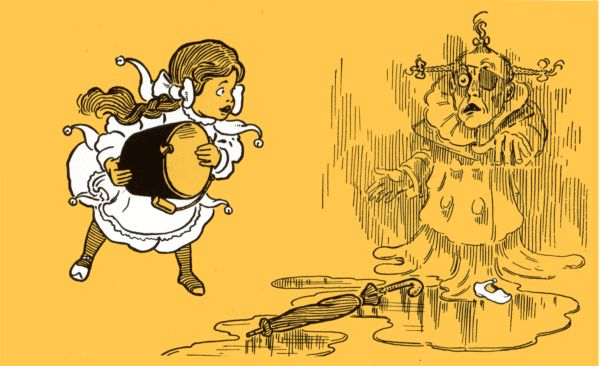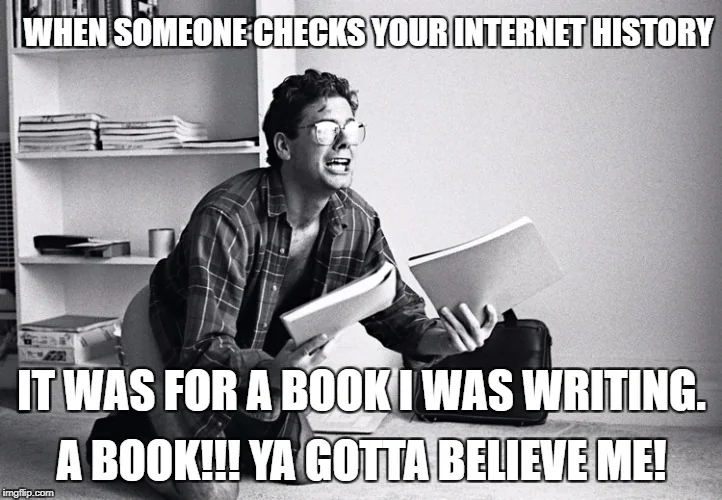I live in Oklahoma. It is the state due south of Kansas and a fellow sufferer of Tornado Season. Like most people in the Midwest, I have several childhood traumas involving thunder storms, rumbling sheet metals roofs, and praying that my family's trailer house didn't get tossed across the meadow.
Currently, I live in a lovely brick house with large interior wall closets. It has done wonders for my anxiety. I now spend milder storms chatting with my reader friends on Discord.
Naturally, most of them are familiar with the Wizard of Oz. Most of my generation has seen the movie even if they haven't read the novels. During the last storm, someone made the comment “Don't squash any witches.”
My response, “If that happened, I am not looting the corpse in front of that witch's older and nastier big sister.”
That led to a very long ramble about funeral practices and related ehtics, and later this blog.
 |
| Illustraion by W.W. Denslow |
A little context into my family tree is needed. I was raised by a geologist and a journalist. However, my parents are not the most interesting career combinations. There's a branch on my paternal side that has worked, run, and owned funeral parlors out in California. Great Uncle Ray and his son David demystified a lot of the icky around the subject.
Needless to say, I grew up with an odd understanding of “what happened after someone dies.” While I didn't have any insights on the metaphysical issues and worries, I knew what people on this side of existence had to handle.
A funeral director has an odd professional function. It's been this way since the Egyptians started mummifying the dead. In the U.S.A., they act socially as an event coordinator for the bereaved. This is a position of great emotional and ethical responsibility. Their job is to give the community a safe and orderly way to grieve the loss.
The other element, the icky one, is safe and orderly cadaver disposal. It's not just about hiding away reminders of our morality. Sources of decay quickly become dangerous to the living.
Most of Ray and David's stories were not about clients, living or deceased, but about people 'backstage.' You get all types in the business, and learning experiences range from awkward to ridiculous chains of events. (For example, if a living person lays down in a coffin, that coffin can't be legally resold for burial. A prankster quickly found himself with a very expensive price tag after a failed jump-scare.) I learned a lot by proxy.
| Illustration by W.W. Denslow |
Circling back around to Oz, I'm not Dorothy Gale. She is a child who lost her parents at an early age and grew up on a farm during the Great Depression. We have extremely different sensibilities and life experiences.
After accidental manslaughter, Dorothy quickly hones in on her goals, getting back to Kansas. She sets out on the Yellow Brick Road to the cheers of the Munchkins and the gifts from the Good Witch (named Glinda in the movie).
I, on the other hand, would not be going anywhere without addressing the issue of the dead body.
Picture this:
The Munchkins are celebrating liberation. The dictator is dead. People are singing and dancing in the street.
Meanwhile the Good Witch watches a shaken Okie piecing together bio-hazard protection. Horrible person or not, the deceased can't stay under my house. I'm having flash-backs to the time Dad had to dig out a burrow under the trailer house because a critter died in there.
Things become yet more complicated when the witch turns to dust. In the movie, this is the scene where the striped socks roll back up under the house, leaving behind the Ruby Slippers. In the book, the Good Witch literally shakes witch dust out of the Sliver Slippers before handing them to Dorothy.
This handily solves the issue of decay. However, my inherited sensibilities will not settled for leaving the rest of the deceased's clothes under my house. The dust itself would be handled with the same care as human ash. I'm going to need a large jar with a lid, and my painter's mask.
By this point, the Good Witch of the North should have serious concerns about my sanity and about handing magic slippers of any color to me. However, magic and fairylands have rules about this type of thing. To the victor go the spoils.
I also have concerns about those slippers. By my reckoning, Glinda has no business giving them to me. This feels scummy. And no, not because she's asking me to wear shoes that someone died in.
You see, funeral parlors and shoes have a long a sordid history. In the old days when shoes were leather and expensive, more than a few undertakers would remove the shoes after the viewing but before the internment. While up-cycling is good, this was often done without the permission of the people paying for the funeral. The shoes and other valuable items would be sold on the side and the undertaker quietly pockets the money. Grave-robbery before the grave is even filled.
This is disrespectful and dishonest on multiple levels. Modern societies have complex laws about it, and grave clothes are not 'up for grabs.'
So, I ask if the deceased had any surviving next-of-kin.
Now, in the slower paced book, the two Wicked Witches hated and avoided each other. However, in the movie, this is the point where the Wicked Witch of the West, shows up.
 |
| Margaret Hamilton in The Wizard of Oz 1939 |
“Who killed my sister?! Who killed the Witch of the East?!”
Margaret Hamilton's performance terrified me as a small child. Now however, I'm a 5-foot 5-inch woman who has a younger sister who has nearly died in a car accident. I can recognize anger masking grief.
So, I have a jar of remains, a pile of neatly folded clothes, and magical shoes. Logically, all those items belong to the living witch. If Glinda magics the slippers onto my feet, I'm not going to be happy. That's receiving stolen goods. No thanks.
Luckily for Oz, I really dislike being screamed at or threatened. I would like to think myself mature enough to deescalate even when faced with a ranting witch. However, there is a reason I did not enter the family business. The minute she snarks 'I can cause accidents too' the sympathy bouquet goes away and the pepper-spray comes out.
Ironically, despite all my life experience and 'adult sensibilities' I don't see myself changing the story too much. Like Dorothy, I would want to get back home to my family. Like Dorothy, I have issues with setting out to destroy another witch, this time on purpose, but I would still try.
No, the main difference between me and Dorothy is that when faced with a brown, shapeless mess of melted witch goo, I would be looking for another jar. Dorothy literally throws more water on the remains and sweeps them out the door.
 |
Illustration by W.W. Denslow





